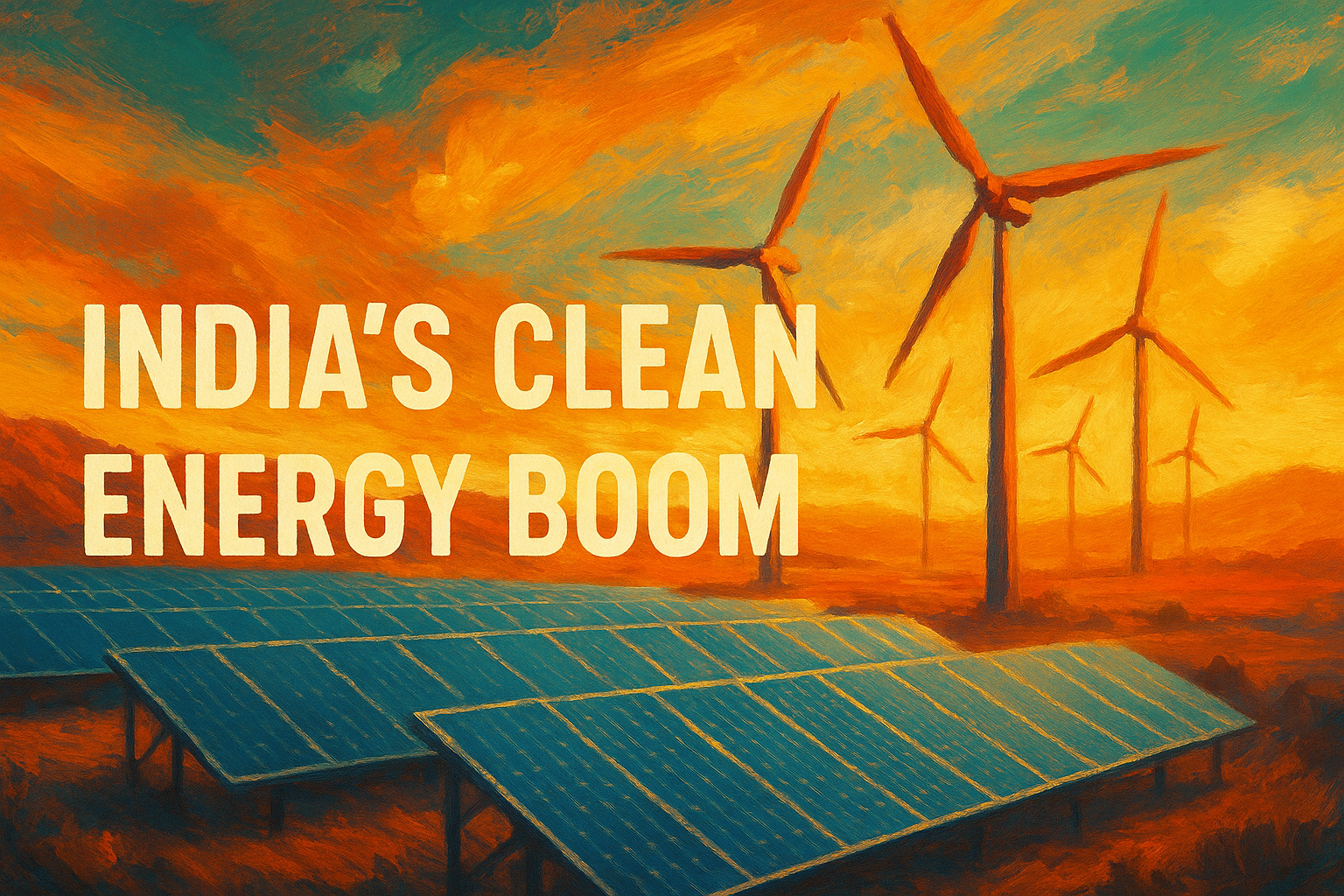India’s commitment to clean energy remains unshaken, even as parts of the world falter on climate promises. With a goal of 500 GW clean energy capacity by 2030 and net-zero emissions by 2070, the country is pursuing an ambitious transition supported by policy incentives, rising market participation, and growing investor interest. Yet, behind the optimism lies the question: are valuations running ahead of fundamentals?
Government-led tailwinds
India’s renewable energy journey has been fueled by government initiatives. Programs like PM-Surya Ghar for free rooftop solar electricity, PM-KUSUM for removing diesel from agriculture, and PLI schemes to boost solar PV manufacturing have created a robust ecosystem.
The results are evident. India now ranks fourth globally in renewable capacity, having achieved over 50% clean energy in its power mix five years ahead of schedule. Between 2014 and 2025, renewable capacity grew at a 10.5% CAGR to reach 227 GW, with the 2030 target of 500 GW requiring a 17% CAGR over the next five years.
Market enthusiasm and valuation surge
This growth story has spilled into the capital markets. IPOs from Vikram Solar, Inox Clean Energy, and Clean Max Enviro Energy are already underway, with Hero Future Energies expected to follow.
But investor enthusiasm has led to sky-high valuations:
- NTPC Green Energy trades at a P/E of 156 with a modest ROE of 3.9%.
- SJVN and ACME Solar Holdings have ROEs below 8% yet command P/Es above 40.
- Borosil Renewables, despite losses, has delivered an 8,000% return since 2018.
The willingness to overlook weak returns reflects the market’s faith in long-term growth—but it raises concerns about sustainability at these multiples.
Solar leads, others catch up
Not all renewables share the same trajectory.
- Solar power dominates, growing at nearly 40% CAGR since 2014 as costs fell, floating panels addressed land scarcity, and government schemes incentivized adoption.
- Wind energy, hampered by land requirements and environmental concerns, is expected to grow at a faster clip post-2025 but lags far behind solar.
- Nuclear power remains limited by regulatory challenges, while biofuels are too small in scale to make a major impact.
Solar’s scalability, declining costs, and compatibility with energy storage solutions explain its leading role.
Concentration risks and diversification trends
Clean energy production remains seasonal and geographically concentrated. Solar power thrives in Gujarat and Rajasthan, while wind power is most viable in coastal and hilly areas. This concentration risk makes producers vulnerable to regulatory and weather shocks.
Players like Adani Green, NTPC Green, and KPI Green Energy have diversified across energy sources to reduce risk. Even traditionally focused players like SJVN and Azure Power have expanded into multiple renewable segments to stabilize returns.
Interestingly, solar-focused companies have enjoyed higher ROEs—with Websol Energy and Waaree Renewables posting ROEs of 80.2% and 65%, respectively—but diversification remains key for long-term resilience.
Policy uncertainty and obsolescence risks
Government incentives remain the backbone of the industry, but history shows they can be rolled back abruptly. Changes in accelerated depreciation rates for solar and wind projects in the past illustrate this risk. State-level policies, such as Gujarat’s banking charges on solar power, add another layer of unpredictability.
Technological obsolescence poses yet another challenge. Websol Energy had to write off major investments after its technology became outdated, highlighting how first movers in energy storage and solar technology risk rapid irrelevance as innovations accelerate.
The bottom line for investors
India’s clean energy growth story is undeniable, backed by policy, market interest, and technological progress. Yet, valuations demand caution.
- Larger, diversified players with deeper pockets are better placed to handle policy volatility, tech disruptions, and geographic risks.
- Smaller, concentrated firms may struggle unless they demonstrate clear competitive advantages.
- Market exuberance, reflected in triple-digit P/Es for low-ROE companies, suggests that investors should carefully balance growth potential with valuation discipline.
India’s clean energy sector promises to be a multi-decade story—but its winners will likely be those combining scale, diversification, and financial resilience rather than speculative momentum.
Feel free to share your experiences and insights in the comments below. Let’s continue the conversation and grow together as a community of traders and analysts.
By sharing this experience and insights, I hope to contribute to the collective knowledge of our professional community, encouraging a culture of strategic thinking and informed decision-making.
As always, thorough research and risk management are crucial. The dynamic nature of financial markets demands vigilance, agility, and a deep understanding of the tools at your disposal. Here’s to profitable trading and navigating the election season with confidence!
Ready to stay ahead of market trends and make informed investment decisions? Follow our page for more insights and updates on the latest in the financial world!
For a free online stock market training by Yogeshwar Vashishtha (M.Tech IIT) this Saturday from 11 am – 1 pm, please sign up with https://pathfinderstrainings.in/training/freetrainings.aspx
Experience profits with my winning algo strategies – get a free one-month trial with ₹15 lakh capital! – https://terminal.algofinders.com/algo-terminal
Disclaimer
This article should not be interpreted as investment advice. For any investment decisions, consult a reputable financial advisor. The author and publisher are not responsible for any losses incurred by investors or traders based on the information provided.


